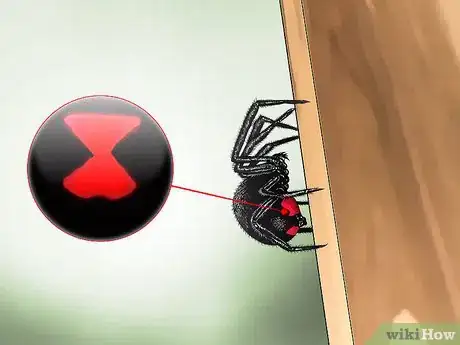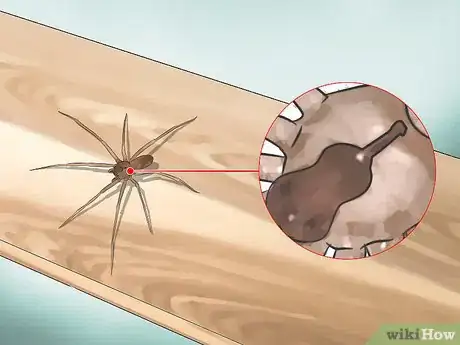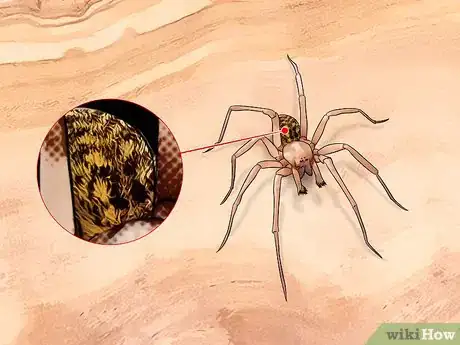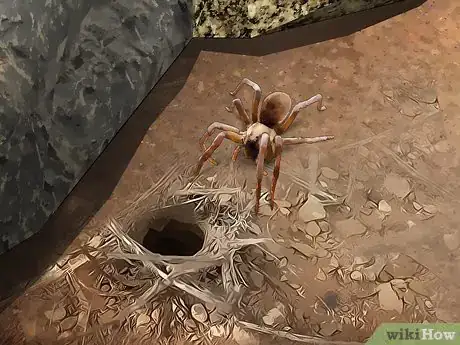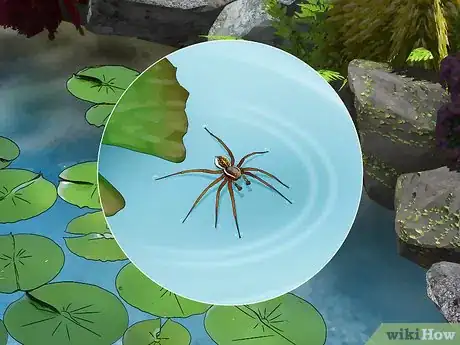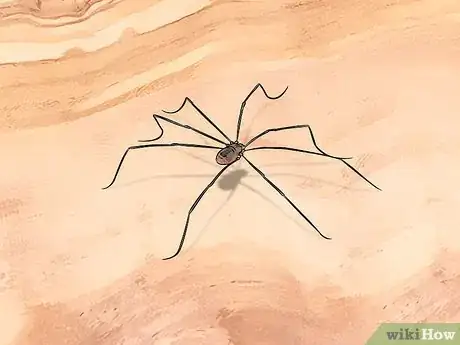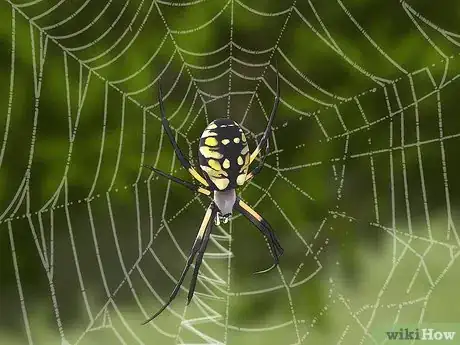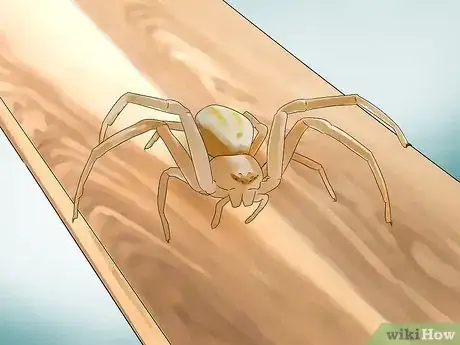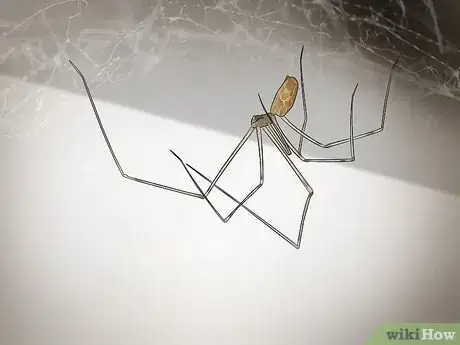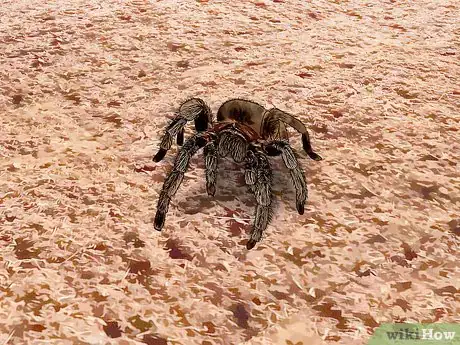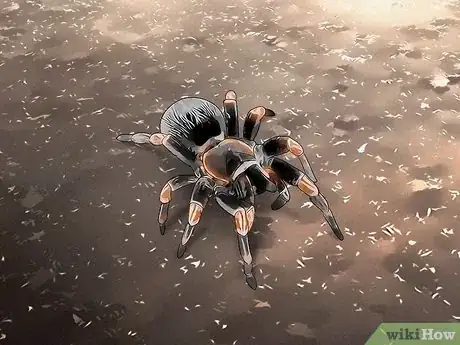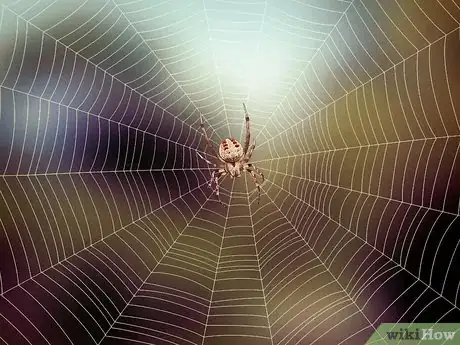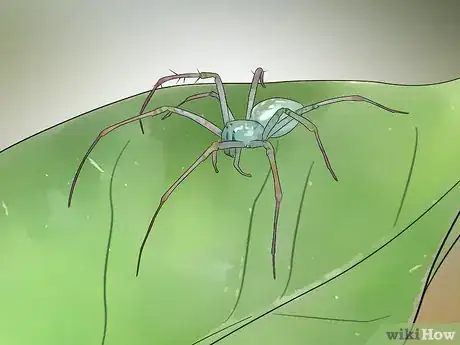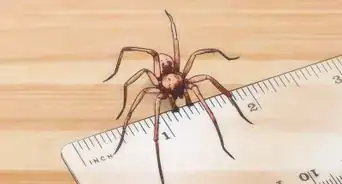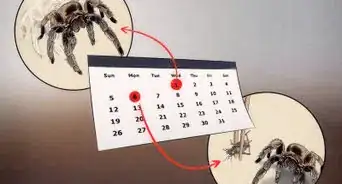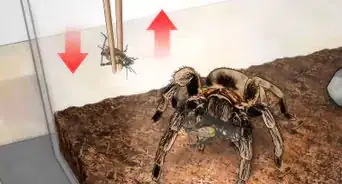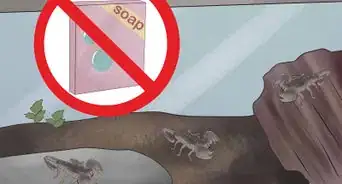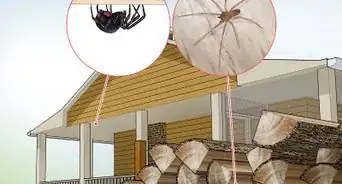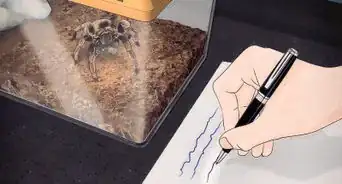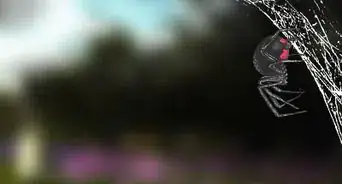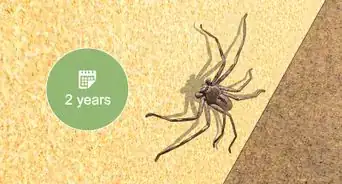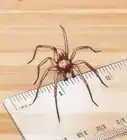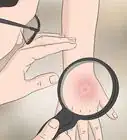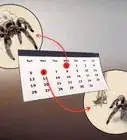This article was co-authored by Shweta Sharma. Shweta Sharma is a Biologist with the U.S. Environmental Protection Agency (EPA). With nearly ten years of experience, she specializes in insect management, integrated pest management, insect behavior, resistance management, ecology, and biological control. She earned her PhD in Urban Entomology and her MS in Environmental Horticulture from the University of Florida. She also holds a BS in Agriculture from the Institute of Agriculture and Animal Sciences, Nepal.
There are 14 references cited in this article, which can be found at the bottom of the page.
This article has been viewed 74,111 times.
Of the 40,000 spider species worldwide, there are more than 3,400 that make their habitat in the countries of North America.[1] Fortunately, it’s relatively straightforward to identify several of the most common spider species found in Canada, the Caribbean countries, Mexico, and the United States. You can identify many spiders based on the type of web they construct. But, there are some spiders, such as hunting spiders, that don’t create webs, and there are some spiders that create webs underground that most people never see. So, also identify spiders through visual identification based on their physical size, color, and shape.
Steps
Identifying Venomous and Dangerous Spiders
-
1Look for a red hourglass on the abdomen of a black widow. You can identify a black widow easily by looking at the underside of its abdomen: there will be a red hourglass figure on its shiny, black surface. The abdomen of a black widow itself is rounded, glossy, and completely hair-free. With legs outstretched, a black widow can reach about 1 inch (25 mm) in size.[2]
- Black windows are extremely venomous and their bites can be lethal to humans. Visit an emergency room immediately if you’re bitten.
- Black widows are most common throughout the continental U.S., Mexico, and the Caribbean. They can also be found in Canada, although the extreme cold may deter them
-
2Identify brown recluse spiders by the violin shape on their abdomen. As the name suggests, brown recluses are always dark brown in color. On the back of their thorax (where the legs attach to the body), you can spot a roughly violin-shaped marking. The spiders aren’t too big, as their bodies typically measure only 1⁄4–3⁄4 in (0.64–1.91 cm) long.[3]
- Brown recluses live on the east coast of the United States and are especially concentrated in the South.
- The bite from a brown recluse is extremely painful and can prove fatal to humans. If you’ve been bitten by a brown recluse, go to the hospital immediately.
Advertisement -
3Distinguish hobo spiders by their brown, chevron-patterned backs. Hobo spiders have a relatively small body that’s typically only 1⁄2–2⁄3 in (1.3–1.7 cm) long, but their slender legs can span as much as 2 inches (5.1 cm). The spiders are typically a nondescript brown color. However, both male and female hobo spiders have multiple V-shaped markings on their backs.[4]
- While a bite from a hobo spider may not hurt or swell over the first 24 hours, the affected area will blister and begin to ooze pus within 36-48 hours. As it worsens, the bite can become quite serious.
- Hobo spiders live mostly in the American west and northwest and are typically found in the ground levels of homes.
-
4Locate wolf spiders hunting on the ground or near a burrow. Wolf spiders are hunters and don’t create webs to catch their prey, so you’re very unlikely to see one in a web. So, look for this dark brown spider as it scurries along the ground searching for insects to eat. They’re relatively large, and can grow as large as 30 millimetres (1.2 in). If you see the spider scurry into a burrow, it’s almost certainly a wolf spider.[5]
- Be aware that although wolf spiders prefer to live and hunt outdoors, they will seek warmer places to live, such as your home, when the weather turns cold. The spiders are most common in the eastern and central regions of the U.S.
- You can physically identify a female wolf spider by the fairly large egg sac they carry around on their bodies.[6]
- Wolf spiders are venomous but not lethal. Large ones can deliver a painful bite.
-
5Find fishing spiders near bodies of water. As the spider’s name implies, they are often around or in bodies of water including ponds, swamps, and streams. You may also spot fishing spiders on or near vegetation close to a water source. Fishing spiders are relatively large and, with their legs extended, can have a body span of up to 3 inches (76 mm). They are venomous, but the venom is rarely dangerous to humans.[7]
- Most fishing spiders are light brown or grey and have parallel white markings running along their backs.
- Fishing spiders are most commonly found in eastern Canada, although they also inhabit portions of the eastern U.S.
- See if the spider appears to “skate” across the water. The fishing spider can also dive under the water to catch prey.
- Fishing spiders are also sometimes known as “dock spiders.”
Finding Common, Non-Dangerous Spiders
-
1Locate common house spiders by their messy, tangled webs. Common house spiders make webs in the corners of indoor rooms, most often in attics and cellars. These webs can be quite large—sometimes as big as 2 feet (0.61 m) across—but aren’t strong and often break and become cobwebs. Most common house spiders range in size from 1⁄3–2⁄3 in (0.85–1.69 cm) in length.[8]
- The spiders have no striking identifying marks, such as an hourglass or violin shape, but are typically light brown in color. Their legs may be a light yellow color with darker rings around the ends and middle joints. The spiders live throughout the continent and make their homes in every region of North America.
- Although common house spiders and their large webs can be inconvenient and unsightly, the spiders aren’t poisonous and almost never bite humans.
-
2Identify daddy long-legs by their spindly legs and undivided body. Daddy long-legs technically are not a species of spider. As such, they do not produce silk and have no venom glands. Daddy long-legs hunt on the ground, and you can identify them rather easily by looking for their long legs and small bodies.[9] While the legs of a daddy long-legs can reach 2 inches (5.1 cm), their small bodies rarely grow larger than 1⁄4 in (0.64 cm).
- Like several of the other species mentioned, daddy long-legs live throughout all regions of North America. However, you’re unlikely to see them outdoors during the winter months.
-
3Find brightly-colored garden spiders in zig-zag-patterned webs. Garden spiders tend to build their zig-zagging webs relatively low to the ground in gardens and forested areas. Sometimes they’re as low as 1 foot (0.30 m) off the ground. The spiders themselves have a highly visible yellow and black pattern and can grow quite large: sometimes as long as 5–28 mm (0.20–1.10 in).[10]
- Garden spiders—including the black and yellow garden spider and the silver garden spider—live throughout the U.S. and Canada. That said, they’re relatively uncommon in the Rocky Mountains.
-
4Spot crab spiders by their large, rounded abdomens. There are many species of crab spiders and their habitat spans all of North America. Most types of crab spiders are identifiable, though, by their large, bulbous abdomens. Crab spiders also have protruding, oversized front legs that resemble crabs’ claws. While some species are muted brown, others have a bright yellow or green color.[11]
- Crab spiders don’t spin webs, so they typically hunt from inside large flowers or flower bushes.
- Crab spiders are relatively small. Adults typically grow to sizes of 5–10 millimetres (0.20–0.39 in).
- Behaviorally, watch the spiders to see if they “play dead” when you approach. Common house spiders are shy and are most likely to pretend they are dead if they feel threatened.
-
5Watch small jumping spiders for jerky movements as they walk. Jumping spiders almost seem to lurch along as they walk, due to the orientation of their short, almost stumpy legs. They have oval-shaped abdomens that, similarly to a tarantula, are covered with very small hairs. The front 2 legs of a jumping spider are larger than its other 6.[12]
- Although they’re only 1⁄2–3⁄4 in (13–19 mm) long, these spiders can jump many times their own body length.
- Also observe its eyes; the 2 middle eyes are quite large when compared to the other 6 eyes.
- Look for jumping spiders hunting prey indoors and out. Jumping spiders do not build nests, but hunt their prey actively and can move over large areas of land. Jumping spiders prefer to hunt during the day and they jump on their prey, hence their common nickname.
- There are many distinct species of jumping spider. While most of them have limited ranges, jumping spiders live throughout North America, except for northern and western Canada.[13]
-
6Look for cellar spiders in cool, damp, and dark locations. Although cellar spiders do not exclusively dwell in cellars, they’re often found in basements or garden-level floors throughout North America. You can locate them easily by looking for their webs, which are usually in corners near the ceiling.[14]
- Cellar spiders have very long, spindly legs that can reach up to 2 inches (5.1 cm) each. They also have a relatively long, narrow, brown-colored body that’s typically about 1–2 inches (2.5–5.1 cm) in length.
- Cellar spiders are often mistaken for daddy long-legs. You can tell the 2 species apart rather easily, though: daddy long-legs don’t have 2 distinct body parts, and cellar spiders do.
- While cellar spiders are harmless, some people consider them a pest. Remove cellar spiders by eliminating their webs. They are also less likely to reappear if you reduce the humidity in your cellar.
-
7Note the large size and fuzzy texture of a tarantula. You aren’t likely to misidentify a tarantula—they are among the largest spiders in the world with a body typically between 1.5–2 inches (38–51 mm). Their bodies are also covered in fine, sharp hairs, giving tarantulas a fuzzy appearance.[15]
- Wait for nightfall for your best chance to spot a tarantula. They hide in their burrows during the day and hunt after dark. Tarantulas do not use webs to hunt, and so spend most of the evening and nighttime hours stalking and overpowering their prey.
- While tarantulas are 1 of the most common spider species in the Caribbean, they’re often also found in the American southwest.
- Tarantula species do produce silk and use it to line the interior of their burrows, but this is seldom seen by humans.
-
8Look for a striking pattern on an orange-kneed tarantula’s leg joints. In most species of orange-kneed tarantula, the “knees” are bright orange or red. You’ll be able to see these distinctive markings on the 2 primary joints in all 8 of the spider’s legs. These vivid markings are unique to this species of tarantula.[16]
- Also, notice the carapace (the hard outer shell of the spider’s body): it is black and will have a brownish-red color around the perimeter.
- Most orange-kneed tarantulas will stay in their burrows during the daylight hours, so you’re not likely to spot one when the sun’s up.
- As their name suggests, Mexican orange-kneed tarantulas live mostly in Mexico, but also in the southern states of the U.S.
- When you do see one, pay attention to the spider’s size: Mexican orange-kneed tarantulas are quite large, reaching up to 15 centimetres (5.9 in).
- While the tarantula’s venom is not lethal—or particularly harmful—to humans, their bite hurts about as much as a bee sting.
-
9Observe the varied and bright coloring of orb-weaving spiders. Most orb-weavers range in color from orange-brown to very brown or black. There are a variety of orb-weaving species; some have intricate patterns on their backs in yellow or green. When identifying an orb spider, check for a round abdomen and an overall body size of about 6–20 millimetres (0.24–0.79 in).
- Try to observe the spider in its web. An orb-weaver will sit head down in the center of its web.
- Orb weavers can be tricky to identify since they exist in a wide variety of sizes, shapes, and colors. The also live in a variety of indoor and outdoor habitats throughout North America that include grasslands and the corners of homes.
-
10Identify green lynx spiders throughout Mexico and the southern U.S. As their name suggests, the bodies of green lynx spiders have a noticeable leaf-green tint. Their legs and abdomens are also colorful: the legs of a green lynx spider typically have orange bands, and their abdomens contain multiple V-shaped markings.[17]
- The spiders themselves are relatively small and only reach sizes between 12–16 millimetres (0.47–0.63 in).
- Green lynx spiders most commonly live in Mexico, although you may spot them in the southern U.S. and on some Caribbean islands.
- Lynx spiders do not build webs. Instead, they stalk their prey along the ground and pounce on small insects to attack them.
Community Q&A
-
QuestionWhich species of spider is largest in North America?
 Community AnswerHogna carolinensis, the Carolina Wolf Spider. The female's body is typically 25 millimeters and the male's is typically 19 millimeters.
Community AnswerHogna carolinensis, the Carolina Wolf Spider. The female's body is typically 25 millimeters and the male's is typically 19 millimeters. -
QuestionWhat spider is about 1.3 inches including legs and it looks yellow-desert?
 Community AnswerThere are many yellow-ish spiders, but the two that come to mind first are Sicarius (also dubbed Sand Spider because it covers itself with sand for hunting purposes) and Cheiracanthium inclusum (these spiders are found in many homes in North America and Europe).
Community AnswerThere are many yellow-ish spiders, but the two that come to mind first are Sicarius (also dubbed Sand Spider because it covers itself with sand for hunting purposes) and Cheiracanthium inclusum (these spiders are found in many homes in North America and Europe). -
QuestionWhat species of spider is largest in North America?
 Community AnswerThe Carolina wolf spider is the largest spider that can be found in North America.
Community AnswerThe Carolina wolf spider is the largest spider that can be found in North America.
Warnings
- Keep in mind that even a nonpoisonous spider bite can cause a reaction. Reactions can be severe if you’re allergic to the spider’s venom.⧼thumbs_response⧽
- Even though almost all spiders are not aggressive towards humans, they can and they will bite if you disturb them. When observing any kind of spider, keep at least 2–3 feet (0.61–0.91 m) away from it.⧼thumbs_response⧽
- Bites often result when people accidentally bother a spider, such as when they handle their shoes or clothing and find a spider hiding out.⧼thumbs_response⧽
- Seek medical attention if you experience more than mild symptoms from any spider bite.⧼thumbs_response⧽
References
- ↑ https://www.insectidentification.org/spiders.asp
- ↑ https://www.insectidentification.org/insect-description.asp?identification=Southern-Black-Widow
- ↑ https://www.insectidentification.org/insect-description.asp?identification=Violin-Spider-Brown-Recluse
- ↑ http://www.wci.colostate.edu/Assets/pdf/id.hobo.spider.pdf
- ↑ https://pestcontrolcanada.com/spider-identification-photos/
- ↑ http://www.biology.ualberta.ca/bsc/news18_1/spider.htm
- ↑ https://www.insectidentification.org/insect-description.asp?identification=Fishing-Spider
- ↑ https://ipminstitute.org/wp-content/uploads/2016/06/Spider-Guide-Wegner-BASF-Revised-12-2-14.pdf
- ↑ https://bugguide.net/node/view/2405
- ↑ https://www.insectidentification.org/insect-description.asp?identification=Black-and-Yellow-Garden-Spider
- ↑ https://www.insectidentification.org/insect-description.asp?identification=Crab-Spider-Mecaphesa
- ↑ https://ipminstitute.org/wp-content/uploads/2016/06/Spider-Guide-Wegner-BASF-Revised-12-2-14.pdf
- ↑ https://www.insectidentification.org/insect-description.asp?identification=Jumping-Spider
- ↑ https://pestcontrolcanada.com/spider-identification-photos/
- ↑ https://ipminstitute.org/wp-content/uploads/2016/06/Spider-Guide-Wegner-BASF-Revised-12-2-14.pdf
- ↑ https://www.insectidentification.org/insect-description.asp?identification=Mexican-Orange-kneed-Tarantula
- ↑ https://www.insectidentification.org/insect-description.asp?identification=Green-Lynx-Spider
